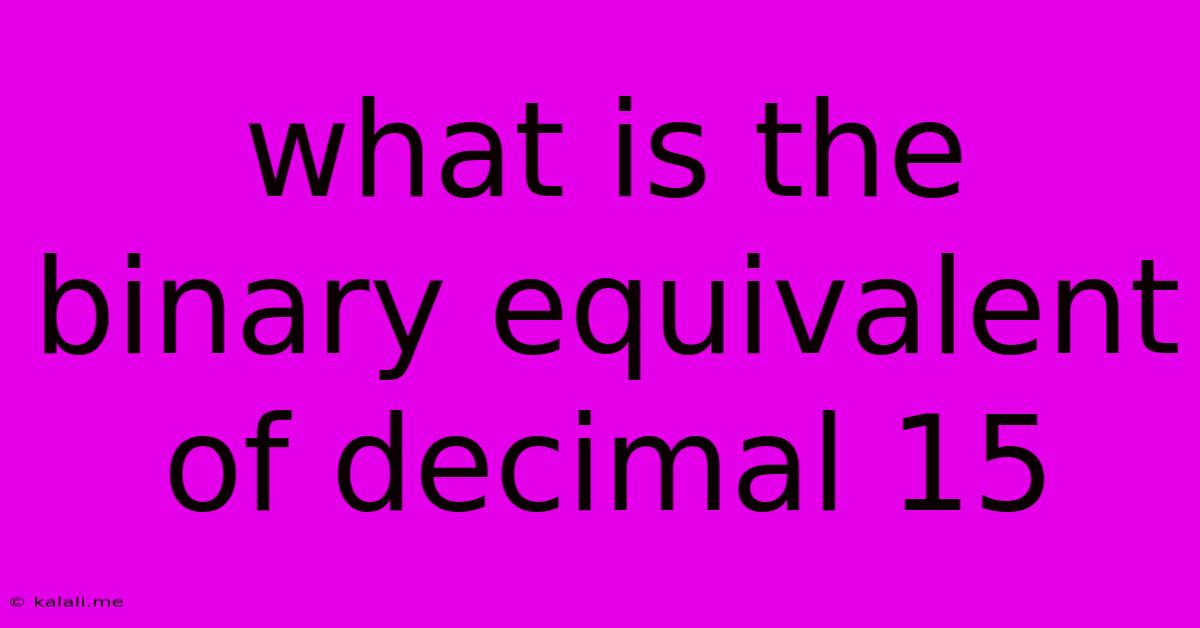What Is The Binary Equivalent Of Decimal 15
Kalali
Jun 16, 2025 · 3 min read

Table of Contents
What is the Binary Equivalent of Decimal 15? A Simple Guide
Finding the binary equivalent of a decimal number is a fundamental concept in computer science. This article will clearly explain how to convert decimal 15 to its binary counterpart, providing a step-by-step guide you can easily follow. Understanding this process is crucial for anyone working with digital systems or programming. We'll also explore the broader context of decimal to binary conversion.
Understanding Binary and Decimal Systems
Before diving into the conversion, let's quickly recap the two number systems:
-
Decimal System (Base-10): This is the number system we use every day. It uses ten digits (0-9) and each position represents a power of 10. For example, the number 123 is (1 x 10²) + (2 x 10¹) + (3 x 10⁰).
-
Binary System (Base-2): This system is used by computers. It only uses two digits (0 and 1), and each position represents a power of 2.
Converting Decimal 15 to Binary
There are two main methods for converting decimal numbers to binary:
Method 1: Repeated Division by 2
This is a straightforward method involving repeatedly dividing the decimal number by 2 and recording the remainders.
- Divide 15 by 2: 15 ÷ 2 = 7 with a remainder of 1.
- Divide the quotient (7) by 2: 7 ÷ 2 = 3 with a remainder of 1.
- Divide the quotient (3) by 2: 3 ÷ 2 = 1 with a remainder of 1.
- Divide the quotient (1) by 2: 1 ÷ 2 = 0 with a remainder of 1.
Now, read the remainders from bottom to top: 1111.
Therefore, the binary equivalent of decimal 15 is 1111.
Method 2: Place Value Method
This method uses the powers of 2. We find the largest power of 2 that is less than or equal to 15, then subtract it and repeat the process.
- The largest power of 2 less than or equal to 15 is 2³ (8).
- Subtract 8 from 15: 15 - 8 = 7.
- The largest power of 2 less than or equal to 7 is 2² (4).
- Subtract 4 from 7: 7 - 4 = 3.
- The largest power of 2 less than or equal to 3 is 2¹ (2).
- Subtract 2 from 3: 3 - 2 = 1.
- The largest power of 2 less than or equal to 1 is 2⁰ (1).
- Subtract 1 from 1: 1 - 1 = 0.
This gives us: 2³ + 2² + 2¹ + 2⁰ = 8 + 4 + 2 + 1 = 15. Representing this in binary, where each power of 2 corresponds to a bit, we get 1111.
Verification
Let's verify our result:
1111₂ = (1 x 2³) + (1 x 2²) + (1 x 2¹) + (1 x 2⁰) = 8 + 4 + 2 + 1 = 15₁₀
This confirms that 1111 is indeed the correct binary representation of decimal 15.
Conclusion
Converting decimal numbers to binary is a fundamental skill in computer science and digital electronics. Both the repeated division and place value methods provide efficient ways to perform this conversion. Understanding these methods will allow you to easily translate between these two essential number systems. This knowledge is essential for anyone working with computer programming, digital logic, or any field dealing with binary data.
Latest Posts
Latest Posts
-
How To Create Clickable Image In Html
Jun 16, 2025
-
What Are The Factors Of 121
Jun 16, 2025
-
What Is A Theme Of The Passage
Jun 16, 2025
-
A Company That Provides Access To The Internet
Jun 16, 2025
-
Which Word Is Closest In Meaning To The Underlined Word
Jun 16, 2025
Related Post
Thank you for visiting our website which covers about What Is The Binary Equivalent Of Decimal 15 . We hope the information provided has been useful to you. Feel free to contact us if you have any questions or need further assistance. See you next time and don't miss to bookmark.